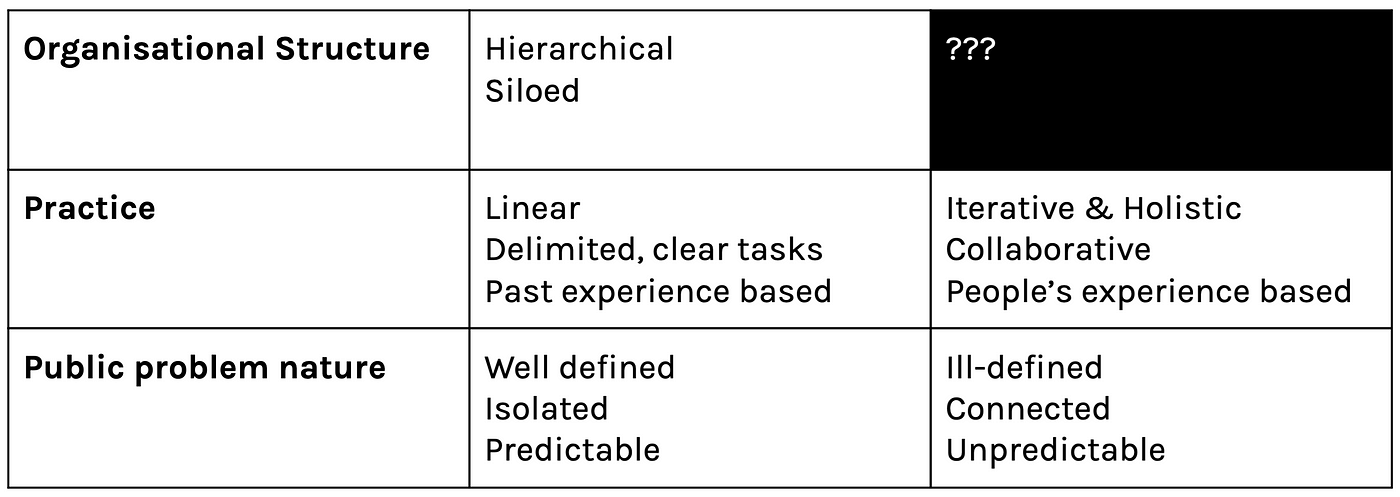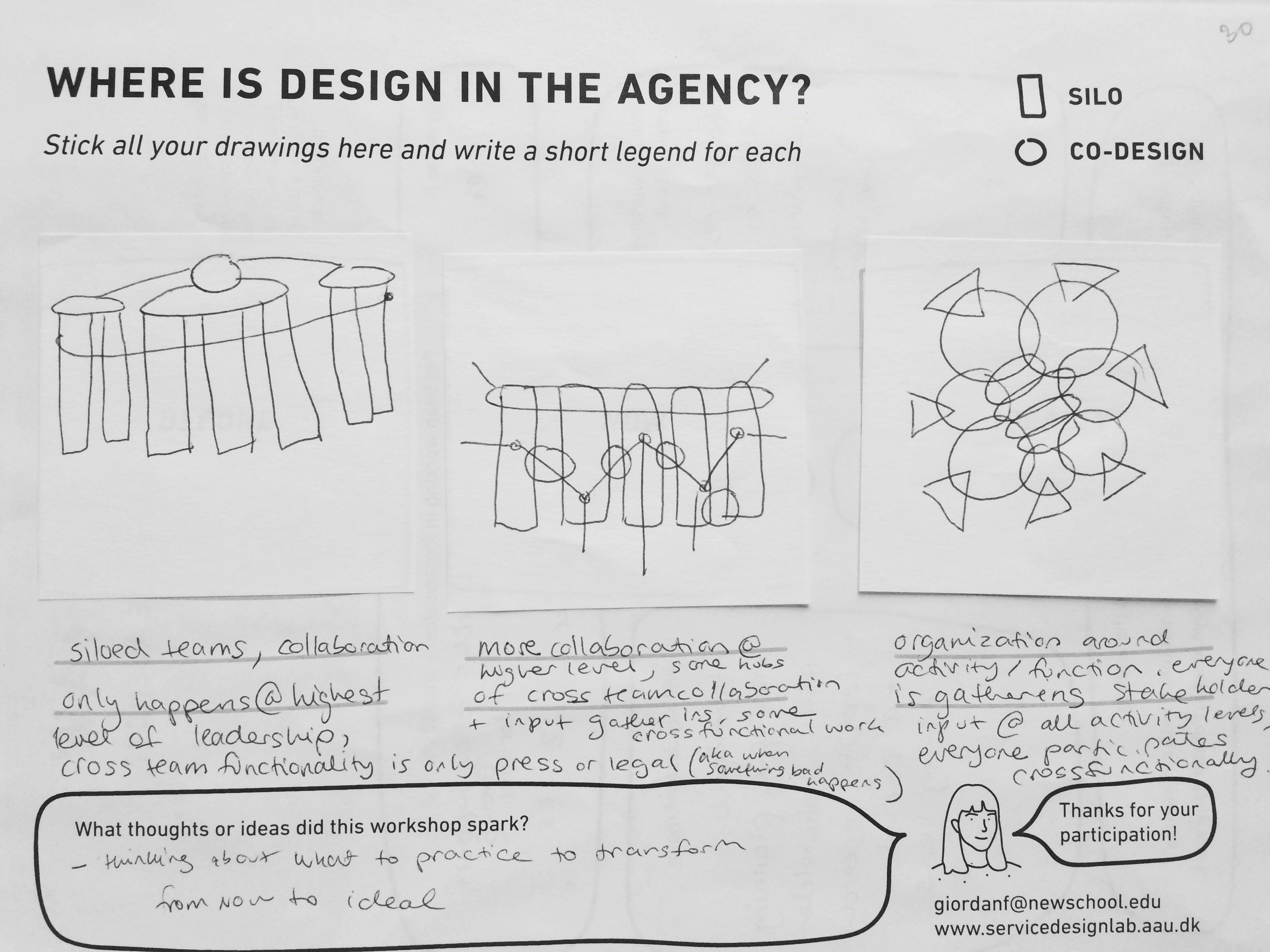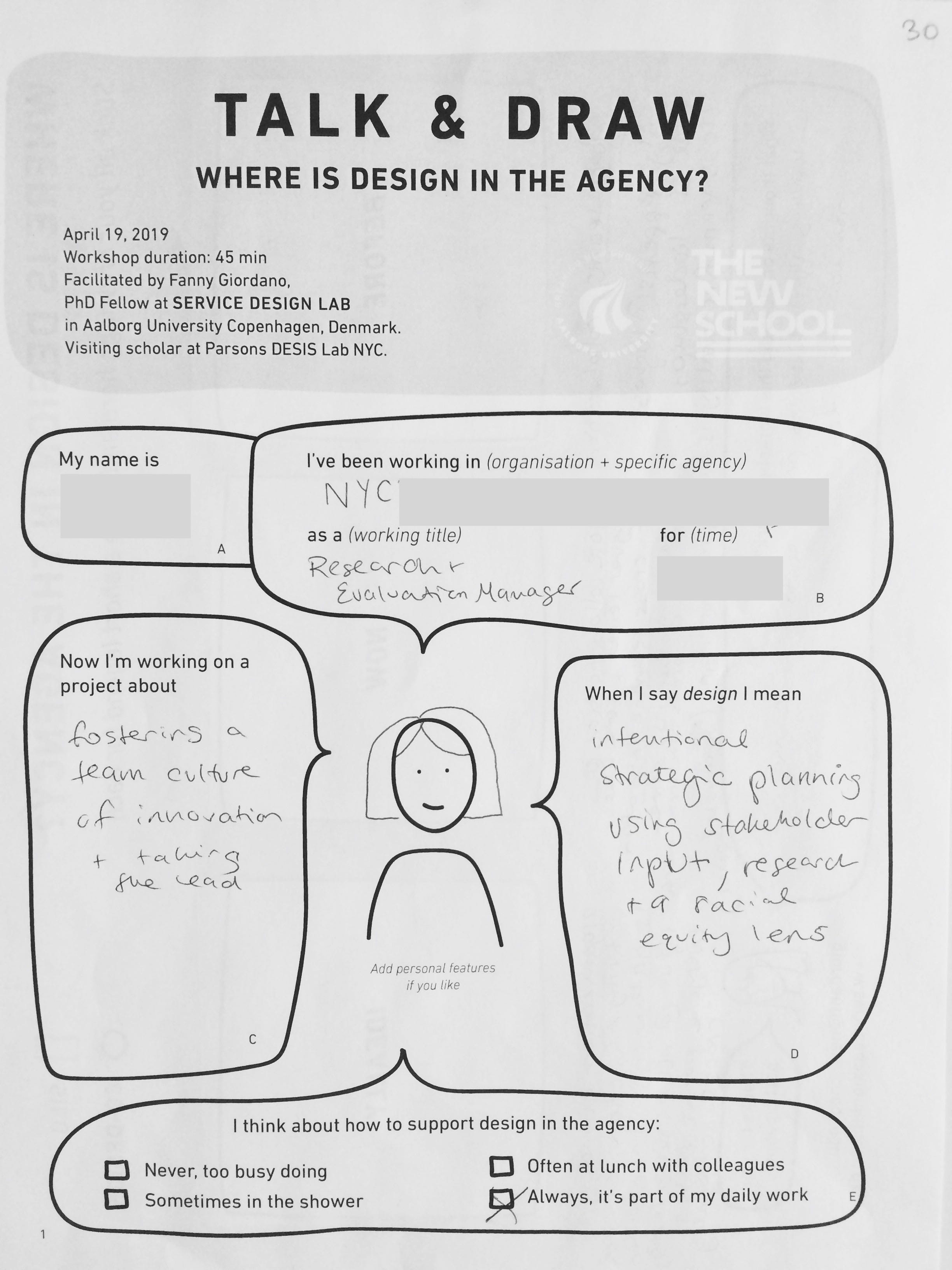Easy Civic Designs Good Easy Drawing Designs Civics
Where is design in government?

Simple question, yet the answer is not as straightforward as one could imagine, but nonetheless fascinating. Between January and June 2019, as a PhD fellow at The Service Design Lab in Aalborg University Copenhagen and a visiting scholar at Parsons DESIS Lab in NYC, I worked with the Service Design Studio to develop a method to explore where design is in the New York City government, but also where else it could be. This semester-long exploration culminated in a workshop with about 60 public servants from NYC government, representatives from the Federal government, as well as a team from the Port Authority of New York & New Jersey. In this article you will learn about the method I developed to question where design exists in government, where it has the potential to grow, as well as how the method was applied in a large workshop and how you can use it in your own organization.
Linking organisational structures, practices and nature of public problems
Hierarchical and siloed are two words that characterise government, especially big city governments. These do not have to be negative terms, they are indeed well suited to support a public management practice that is based on the analysis of past experiences, divides tasks clearly and uses linear processes. This practice is well suited as well to solve well-defined, isolated and predictable problems.
Unfortunately, most of today's public problems are ill-defined, interconnected and unpredictable to a degree that we have never seen before (read more about the "wicked" concept). Take poverty or air pollution for example, it cannot be solved by one organisation or one profession alone. These issues might not be anyway "solvable" but more something that coordinated efforts of multiple actors can continuously address.
This mismatch is one of the reasons why public management practices are currently being redefined and flirting more and more with fields of design and creating new terms like civic service design. Design is a practice that is based on a non-linear, iterative creative process, uses a holistic and collaborative approach as well as empathy. Design, in that sense, is increasingly recognised by scholars and practitioners as to be valuable and adequate to address today's and future ambiguous public problems. For more on this, I suggest reading Christian Bason's book, Leading Public Design: Discovering Human-Centred Governance..
Knowledge gap and challenges
As I explained previously, traditional public management practices are slowly shifting to more design-based management practices. Meaning that the processes, methods and tools used in public administrations are taking inspiration from the design field. However, the organisational structures framing these practices are staying the same. This is problematic because the current organisational structures, ones that are characterized by hierarchy and silos, are not conducive to support the emerging design-management practices. As a consequence, governments do not fully benefit from the design resources in which they invested. A question remains: what are the suitable organisational structures that enable design to flourish?

This topic is not unspoken. On the contrary. As a Deputy Commissioner reported during an OfficeHour with the Service Design Studio:
"Folks have said that organisational structure is the thing that they are most concerned about."
In preliminary interviews, the Deputy Commissioner heard employees clearly saying "we need better organisational structures to do our work," which resonates with several academic voices in the design and design management fields who recently called for knowledge contributions on how to build organisational conditions that enable the use of a design practice in public sector organisations, for example Lisa Malmberg's 2017 thesis Building Design Capability in the Public Sector: Expanding the Horizons of Development and Design Craft in Government by Marzia Mortati, Jesper Christiansen and Stefano Maffei.
This raises the question: what kind of organisational structures are needed to enable the use of a design-based management practice?
This question is still very newly investigated in government and often explored through long interviews with civil servants. These interviews expose various points of views, and public sector leaders don't always know how to deal with those, and sometimes are unclear on how to act on insights.
This raises a second question: How might we facilitate a collective and actionable conversation about this topic?
A method to explore models of organisations
During the 6 month period at The Service Design Studio in NYC, I refined and tested a collaborative and exploratory method.
What is the goal of the method?
The exploratory method that I suggest government employees to use allows for a tangible, effective and actionable conversation about organisational structures and generates models that could potentially enable a design-based management practice to be used in a City government.
How did I come up with it?
This method is the result of an iterative research process which included tests in 4 different settings, with about 70 people who were employed in City government organisations in Geneva, Copenhagen and Paris.
What theories is it based on?
The method is inspired by and is building on existing theories. In particular, on the work of Sabine Junginger, The Design Commission, as well as Inbo Kang and Alison Prendiville — the exact references are written at the end of this article. Their work analysed and described different ways design can be positioned in relation to an organisation and created abstract visualisations. Sabine Junginger suggested a typology of 4 models as you can see in the image below.
All three contributions are very useful to understand generally how design may be positioned in relation to an organisation, why and how it can move from one model to another. However it doesn't account for the complex realities of organisations, especially large ones like big City governments. Indeed, several models can co-exist in the same organisation without a common strategy or coordination. Furthermore the existing visualisations are at such an abstract level that they are far from representing the actual scale and proportions; which may mislead people's perception of the space design is actually taking in an organisation.
What is my contribution?
I used visual communication and participatory design principles to turn these meta-level visualisations into a visual language that expands the list of possible models. Coupled with a participatory method it allows complexity, nuances and multiple perspectives to be expressed. The visual language is based on two simple geometric forms that are very easy to draw: a rectangle and a circle. The general attached meaning to the rectangle shape is a silo, while the circle shape means a design practice. From there, any configuration is possible. Take the following ones as a non exhaustive baseline.
For example, Model #2 can be interpreted as a hierarchical and siloed organisational structure that hired a vendor some design work. The agency is in this configuration mostly in contact with the low management level of one of the departments. Model #8b can be interpreted as a semi-open organisational structure in which a co-design practice is constantly used, connecting internal staff with external stakeholders.
How to use the visual language to create narratives and open a conversation about organisational structures?
It's simple. It goes in three steps, three questions:
- How do you understand the situation NOW?
Draw how the organisational structure of your City agency looks like today. Where is design in relation to it? - How was it BEFORE?
Do you remember where design used to be positioned? Draw it or skip this question if you don't know. - How do you imagine it IDEALLY?
Where could design be positioned within your agency? To what extent has the structure been modified to support a design-based management practice? Use your previous drawings and other people's drawings as inspiration to draw your own visions.
Applying the method in a large scale setting — Civic Design Forum
The Studio's Civic Design Forum is a community of practice for design-curious City employees. This community is hosted by the Studio in partnership with NYC Gov Lab & Studio at the Department of Information Technology and Telecommunications, and NYC Planning Labs at the Department of City Planning. It is one of those rare occasions in which dozens of employees of NYC government gather to do or learn something together although they are not part of the same team, division, agency or department. The perfect playground for me to apply the method.
On April 19, 2019, Civic Design Forum was hosted at The Port Authority of New York & New Jersey's board room in the World Trade Center. It was a full room, 59 people from 15 different City agencies, as well as 6 people from The Port Authority and 4 from The Lab at OPM, a design studio in the Federal government. Attendees were managers, designers, developers, analysts, advisors; directors, assistants and apprentices mixed. They sat at small tables for the workshop.
At the top of the workshop. I gave an introduction focused on sharing each other's understandings of what design means, and presented a below definition of "co-design for policy" to align on a definition together.
I then asked folks to sketch out where design exists in their agency using the legend Rectangle = silo; Circle = co-design and the 3 questions protocol described previously (NOW, BEFORE, IDEALLY). People discussed their drawings with their small groups for about 30 minutes.
I asked everyone to gather their drawings, and write a descriptive caption for each before wrapping up.


Workshop outcomes
145 drawings and descriptive captions were generated, 40 before, 51 now, 54 ideally. Each understood or envisioned model is unique and accounts for the particular perspective of the author.
Options for data diving
All 145 drawings create a large and rich collection that can be analysed, categorised and interpreted in more than one way. Putting all the data collected in an excel sheet is one option for analysis. It is time consuming but uncovers specific insights.
Laying all the drawings out on one big poster is another option which gives an overview and facilitates the identification of general patterns.
An additional option is to print the drawings on small cards with the attached text on the verso. This option allows flexibility in sampling and categorising.
Data diving activity using the cards with Mari Nakano, Eduardo Staszowski, Lara Penin, Matt Khinda, Bonnie Tran, Emily Herrick and Caroline Bauer
Interpretations
All three options of analysis were used here to interpret the collection generated during the Civic Design Forum on April 19, 2019. Here are some of the key findings:
BEFORE. Co-design (the continuous co-creation and negotiation of solutions with people affected by the services or policies)used to be a very weak signal, almost completely absent of the internal organisation or used through contracting as an external resource.
NOW. Co-design practice is more present than before and has been internalised. New connexions have been created. However, the practice is scattered, inconsistently applied, and often limited by current organisational structures. The variety of configurations shows that different ways of positioning and using a co-design practice simultaneously exist in the organisation.
IDEALLY. 4 categories of visions / degrees of modification could be identified as shown in the table below. Each category is a different approach to rethinking governmental organisational structures.
Classification of the visions generated during the workshop facilitated by Fanny Giordano at the Civic Design Forum on April 19, 2019
"I think what's encouraging about seeing all of these messy things is that it's almost like a commentary of undoing the structure and that, that's the solution."
— Eulani Labay, Experience Designer at The Lab at OPM
Considerations for future use and development
If you wish to use this method yourself, in your agency, consider the following and do not hesitate to ask for support from the Service Design Studio.
Where to start? A good way to start may be to invite another team you would like to work closer with. The method can also simply be used individually or during a one-on-one conversation.
Who should participate? Consider who is invited/joining the conversation because that will affect the richness of the discussion and the kinds of visions generated. Dare to mix teams, departments, levels of hierarchy, years of experiences, job positions, genders because it pays off. Having a high variety of people in the room is the only way to get close to a full picture of the complex environment you are working in. And what about outside stakeholders? Citizens? If we want a City government to be good at collaborating with others, we might as well include them in the conversation.
Time it! Set a beginning and ending time in advance and inform all participants.
Legend. Defining and explaining a legend (the meaning you attach to the geometric forms) is crucial because that creates the common language among participants. But don't be too strict about it. Slight variations makes the discussion evolve.
Warm up first. Drawing may be a source of anxiety for some people. De-dramatise the act of drawing. Call it doodling instead. Example of warm up that works: ask participants to draw as many circles as they can on a piece of paper in 10 seconds. Do the same with rectangles. This will help people to see that drawing isn't hard!
During the session
Keep it simple. Use the structure before, now, ideally. Start with now in comparison to before and finish by ideally. You may extend the time on discussing and generating ideally scenarios.
No right, no wrong. There is no right or wrong answer. Silos are not necessarily negative and a model only made out of circles is not necessarily positive or the ultimate goal. Indeed, almost all visions collected had silos to some degree. The optimal structure may be hybrid, nuanced, not homogeneous and not so clear, especially in times of transition. And that's ok! Most importantly the "ideal model" is unique to each City government, and may not be one model only.
Don't say it, draw it! Make sure no one talks too long without illustrating its point because the goal is to keep the conversation as tangible as possible.
Zoom out. Consider zooming in and out. Dare to draw the big picture because that is how you may see new opportunities.
Wrap up. Make sure there is a few minutes of silent time alloted for people to gather, order and stick their drawings on one page as well as to write individually a short explanatory text (2–3 lines max) of what they mean with each of their drawings. This is also a time when participants can reflect.
After the session
Strategic planning. Consider the models drawn as inspiration for strategic planning. The variety of points of view are not incompatible, they may sometimes be considered as different stages in time from the now to an ideally or may help identifying clear different strategies which could then be prototyped one after the other.
Do it regularly. Consider doing it on a regular basis to keep a trace of your evolution, keep the dialog open along the changes.
Capture and archive. Create and update a digital library of all the drawings you help generating (I can recommend Adobe Capture App, it's pure magic), it will be very useful for you process, practical for sharing and it will make you proud ;)
Reading list
Bason, C. (2017). Leading Public Design: Shaping the Next Governance Model. 1st ed. Bristol: Policy Press.
Blomkamp, E. (2018). The Promise of Co-Design for Public Policy. Australian Journal of Public Administration, 00(0), 1–15. https://doi.org/10.1111/1467-8500.12310
Design Commission. (2014). Restarting Britain 2: Design and Public Services. London. Retrieved from https://ojs.unbc.ca/index.php/design/article/view/649/521
Kang, I., & Prendiville, A. (2018). Different journeys towards embedding design in local government in England. In ServDes2018 — Service Design Proof of Concept(pp. 598–611). Linköping University Electronic Press. Retrieved from http://www.ep.liu.se/ecp/article.asp?issue=150&article=049&volume=
Junginger, S. (2009). Parts and Wholes: Places of Design Thinking in Organizational Life. Swedish Design Research Journal, (December 2016), 23–29.
Malmberg, L. (2017). Building Design Capability in the Public Sector: Expanding the Horizons of Development. Linköping University. https://doi.org/10.3384/diss.diva-134167
Mortati, M., Christiansen, J., & Maffei, S. (2018). Design craft in Government. In SerDes2018 — Service Design Proof of Concept(pp. 561–562). Linköping University Electronic Press. Retrieved from http://www.servdes.org/wp/wp-content/uploads/2018/07/46.pdf
This piece of work is part of a three-year PhD study (2017–2020) investigating co-design in city government, supervised by Amalia De Götzen and Nicola Morelli from The Service Design Lab in Aalborg University Copenhagen (Denmark). The project is fully financed by Aalborg University and is conducted in collaboration with the Innovation House of Copenhagen municipality and the Service Design Studio in the Mayor's Office for Economic Opportunity of New York City . Many many thanks to the Service Design Studio team and in particular Mari Nakano, Caroline Bauer, Emily Herrick, Timothy Reitzes, Bonnie Tran and Matt Khinda as well as Markus Kessler from the NYC Administration of Children's Services. Special thanks to Eduardo Staszowski from Parsons DESIS Lab for your guidance and for establishing the collaboration with the Service Design Studio.
Source: https://civicservicedesign.com/where-is-design-in-government-6944c2e53ba7